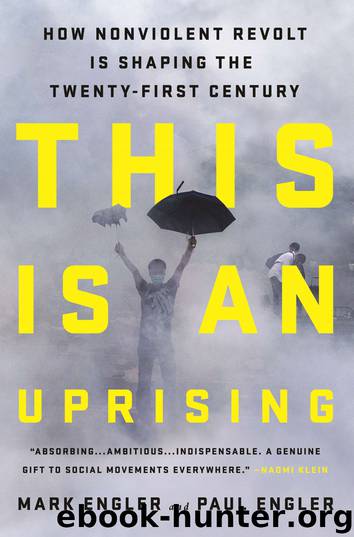This Is an Uprising : How Nonviolent Revolt Is Shaping the Twenty-first Century (9781568585147) by Engler Mark; Engler Paul

Author:Engler, Mark; Engler, Paul
Language: eng
Format: epub
ISBN: 9781568585147
Publisher: Perseus Book Group
Published: 2015-12-23T16:00:00+00:00
“I don’t think I got any sleep for three weeks,” Offner recalls, reflecting on the sit-in. “I don’t think any of the organizers did.” But, in a way, it was expected that the core members behind the campaign, those who had built up the organizational structure of the student-labor group, would be working nonstop. More surprising, she says, were the people who came out of the woodwork and threw themselves into the mobilization. “By two weeks in, what was amazing—it was miraculous, honestly—was to see people who hadn’t really been that involved in the campaign, or hadn’t been involved at all before, weren’t getting any sleep either,” she says. “They were spending all of their time doing something like organizing Tent City. It was incredible.”11
Every so often, we witness a period of intensive protest that seems to defy the accepted rules of politics: where previously apathy had reigned, outbreaks of dissent begin popping up everywhere. Organizers see their rallies packed with newcomers who come from far outside their regular network of supporters. Rather than having to painstakingly work to activate individual supporters, movement veterans are startled to see people motivating themselves to take action. Mainstream analysts, even more taken by surprise, describe something akin to spontaneous combustion. And those in power find that their previously accepted rationalizations for injustice are put under newly intensive scrutiny.
It was during one such moment of peak activity—amid the wave of interest in the civil rights struggle that swelled after the 1961 Freedom Rides—that Saul Alinsky took an excited, middle-of-the-night phone call from protégé Nicholas von Hoffman. After their event with several Freedom Riders at Chicago’s Saint Cyril’s Church was packed beyond capacity, these two organizers agreed on the need to temporarily set aside their normal structure-based methodologies in order to tap into the energy of that extraordinary time. They dubbed the unusual state a “moment of the whirlwind.”12
It was an apt phrase. Although moments of the whirlwind happen across many different social movements, they are rarely reflected upon seriously—or even given a name. Yet, just in the new millennium, we have already seen whirlwinds materialize on a variety of scales. The Harvard Living Wage Sit-In electrified a campus, setting off a rash of defiance and public engagement within a single university community. The protests known as the 2011 Wisconsin Uprising centered on a state capital, Madison, but drew support from citizens throughout the state who were outraged by their conservative governor’s attempts to destroy public sector unions. Occupy Wall Street created a whirlwind at the national level, with encampments springing up from coast to coast, and some forming in other countries as well. Finally, the Arab Spring, which swept through the Middle East, was a whirlwind of global significance, reminiscent of the Revolutions of 1989 in the former Soviet bloc.
The defining attribute of a moment of the whirlwind is that it involves a dramatic public event or series of events that sets off a flurry of activity, and that this activity quickly spreads beyond the institutional control of any one organization.
Download
This site does not store any files on its server. We only index and link to content provided by other sites. Please contact the content providers to delete copyright contents if any and email us, we'll remove relevant links or contents immediately.
The Secret History by Donna Tartt(16623)
The Social Justice Warrior Handbook by Lisa De Pasquale(11489)
Thirteen Reasons Why by Jay Asher(7788)
This Is How You Lose Her by Junot Diaz(5772)
Weapons of Math Destruction by Cathy O'Neil(5037)
Zero to One by Peter Thiel(4824)
The Myth of the Strong Leader by Archie Brown(4789)
Promise Me, Dad by Joe Biden(4447)
Beartown by Fredrik Backman(4419)
Stone's Rules by Roger Stone(4415)
How Democracies Die by Steven Levitsky & Daniel Ziblatt(4399)
The Fire Next Time by James Baldwin(4343)
100 Deadly Skills by Clint Emerson(4078)
A Higher Loyalty: Truth, Lies, and Leadership by James Comey(4033)
Rise and Kill First by Ronen Bergman(4012)
The David Icke Guide to the Global Conspiracy (and how to end it) by David Icke(3882)
The Farm by Tom Rob Smith(3872)
Secrecy World by Jake Bernstein(3782)
The Doomsday Machine by Daniel Ellsberg(3731)
